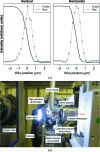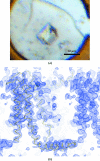Protein microcrystallography using synchrotron radiation
- PMID: 28989710
- PMCID: PMC5619846
- DOI: 10.1107/S2052252517008193
Protein microcrystallography using synchrotron radiation
Abstract
The progress in X-ray microbeam applications using synchrotron radiation is beneficial to structure determination from macromolecular microcrystals such as small in meso crystals. However, the high intensity of microbeams causes severe radiation damage, which worsens both the statistical quality of diffraction data and their resolution, and in the worst cases results in the failure of structure determination. Even in the event of successful structure determination, site-specific damage can lead to the misinterpretation of structural features. In order to overcome this issue, technological developments in sample handling and delivery, data-collection strategy and data processing have been made. For a few crystals with dimensions of the order of 10 µm, an elegant two-step scanning strategy works well. For smaller samples, the development of a novel method to analyze multiple isomorphous microcrystals was motivated by the success of serial femtosecond crystallography with X-ray free-electron lasers. This method overcame the radiation-dose limit in diffraction data collection by using a sufficient number of crystals. Here, important technologies and the future prospects for microcrystallography are discussed.
Keywords: multi-crystal data collection; multi-point data collection; protein microcrystallography; serial synchrotron crystallography.
Figures







References
-
- Batyuk, A. et al. (2016). Sci. Adv. 2, 2375–2548.
Publication types
LinkOut - more resources
Full Text Sources
Other Literature Sources

